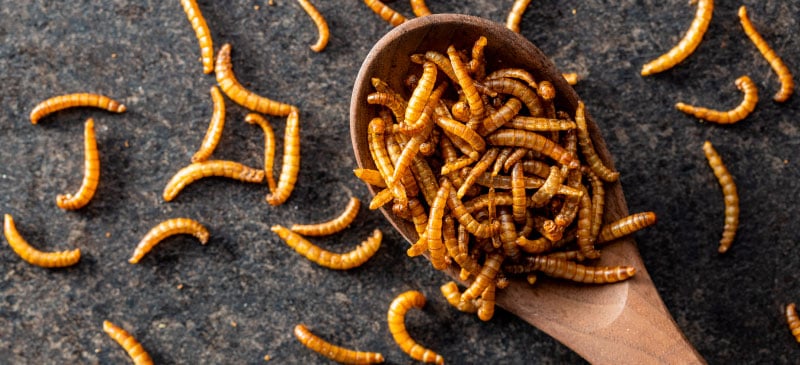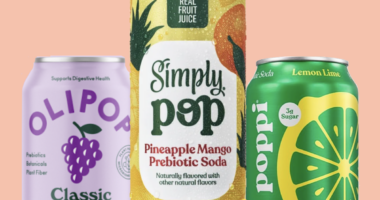
In an effort to find more sustainable sources of protein, researchers at Wonkwang University in South Korea are looking into mealworms as a traditional meat alternative.
The thought of eating mealworms, an edible insect larvae, may not be very appealing, but when seasoned and cooked, they make for a crunchy, salty snack, according to this new report that tested cooking processes to find the best-tasting mealworm flavor possible.
Study Findings: Eating Mealworms
Although edible bugs serve as nutritious and healthy food sources, providing fatty acids, fiber, protein and micronutrients, they have an image problem, researchers admit. That’s why the team at Wonkwang University tested mealworm aromas and flavors to create the most “meat-like” and desirable taste possible.
The hope is that edible insects will be used commercially, providing savory flavorings and seasonings for the convenience food industry.
First, the team sought to understand the flavor profile of mealworms. Researchers compared aromas throughout their lifecycles.
Then the insect’s flavor was tested after using various cooking methods. They found that roasting and frying mealworms made them taste most similar to meat and seafood.
Then the researchers heated the insects with sugar in order to create a meat-like, savory flavor. Samples were made using multiple combinations of powdered mealworm and sugars, and then volunteers were asked to test the samples and provide feedback.
The study concluded with 10 optimized and desirable meat-like flavors using mealworms.
What’s next for the team? The researchers plan to further optimize the mealworm cooking processes in order to reduce any off-flavors or undesirable variables.
Potential Benefits
1. Provide Vital Nutrients
Insects are rich in nutrients and considered a healthy source of fatty acids, protein, fiber, vitamins and minerals. Powdered mealworms can be added to recipes for a savory, meat-like flavor, while providing essential nutrients for human health.
2. Help Meet Food Demand
The United Nation reports that the global population is expected to reach 9.7 billion people by 2050. Feeding all of these people with animal meat will require an enormous amount of land, water and food resources, while contributing greatly to climate change.
READ RELATED: Argentina 'mysterious' pneumonia that killed six 'is Legionnaire's disease', experts find
Insects like mealworms can hel meet food demand because they are nutrient-rich and much easier to raise for human consumption.
3. More Sustainable Than Animal Protein
The increasing interest in insect protein is linked to the environmental impact of raising large animal protein. Insects are considered a low environmental impact food source.
Cows, on the other hand, are a substantial contributor to climate change. Research shows that the livestock sector requires a significant amount of natural resources and plays a major role in global greenhouse gas emissions, including releasing methane and nitrous oxide.
Farming insects is far more sustainable because they convert what they consume to protein more efficiently than larger animals. Insects also require about 12 times less feed to produce the same amount of protein as cattle, pound for pound.
Risks and Side Effects
Because mealworms are not regulated by the U.S. Food and Drug Administration, be careful sourcing them. You can raise them yourself or get them from a reputable seller.
Mealworms and other insects need to be cleaned thoroughly before consumption in order to kill potential parasites.
Do not eat bugs without knowing the type and whether or not they are edible. Some insects are toxic to humans.
How to Use (Recipes)
Because people may be hesitant to eat insects such as mealworms by themselves, they may be more useful when hidden in convenience foods as an added form of nutrients. Mealworm powder that’s cooked to taste similar to meat is what’s being tested for flavor, but you won’t see it as an ingredient in U.S. products quite yet.
Edible insects are not regulated by the FDA for human consumption, so they are not regulated and used in commercial food products. This may begin to change, however, if the FDA follows the lead of the European Food Safety Authority, which approved yellow mealworms for human consumption last year and Lesser mealworms just last month.
If you’re ready to start cooking with mealworms, a common way to prepare them is by first boiling them to remove all dirt (and potential parasites), then draining water and patting them dry. Then you want to dehydrate the mealworms in a dehydrator.
The insects can be added whole to recipes or ground and added like seasoning. Using them with garlic, salt, pepper, lemon juice and fresh herbs enhances the flavor.
Conclusion
- Although insects serve as nutritious and healthy food sources, providing fatty acids, fiber, protein and micronutrients, most Americans would prefer to keep them off their diner plates. A team of researchers tested mealworm aromas and flavors to create the most “meat-like” and desirable taste possible to combat the hesitancy.
- Mealworms are nutrient-rich foods that are more sustainable than raising larger animals for food and can help meet increasing food demand.
- This study shows that when prepared properly ground mealworm powder can be added to convenience foods for increased nutrition without hindering the taste.
Source:






